Sustainable electric vehicle travel through Croatia's countryside
This comprehensive guide reveals how to explore Croatia's breathtaking countryside by electric vehicle this April. Discover hidden gems away from tourist crowds, navigate mountain passes efficiently, and enjoy authentic regional cuisine—all while charging conveniently with easyCharging's expanding network across Istria, central Croatia, and Dalmatia.
As April brings the first genuine warmth and vibrant blooms across Europe, Croatia’s countryside emerges as a premier destination for electric vehicle enthusiasts. Well before the summer tourist crowds arrive, this early springtime journey through Croatia’s rural landscape offers EV drivers a perfect blend of cultural exploration, culinary discovery, and sustainable travel—all while navigating Croatia’s increasingly robust charging network. For those planning an Easter holiday escape, we’ve crafted the definitive guide to exploring Croatia’s picturesque countryside with your electric vehicle.
Why Croatia Is Perfect for Electric Vehicle Holidays in Early Spring
April represents an ideal time for Croatian EV exploration—mild temperatures optimise battery performance while reducing the need for range-sapping climate control. The Easter holiday period creates a perfect opportunity to witness traditional celebrations that add cultural depth to your journey, all while enjoying significantly reduced tourist numbers compared to summer months.
Croatia’s terrain offers tremendous variety for electric vehicle drivers: coastal flatlands, rolling hills, and dramatic mountain passes all within relatively compact driving distances. This geographic diversity creates a thrilling driving experience while allowing you to test your EV’s capabilities in different conditions.
The Ultimate Rural EV Route: Charging with easyCharging
Our carefully planned route ensures you’re always within comfortable range of Croatia’s growing easyCharging network, accessible via the easycharging.app. This journey connects charming villages, historic hamlets, and breathtaking vistas—all supported by reliable charging infrastructure.
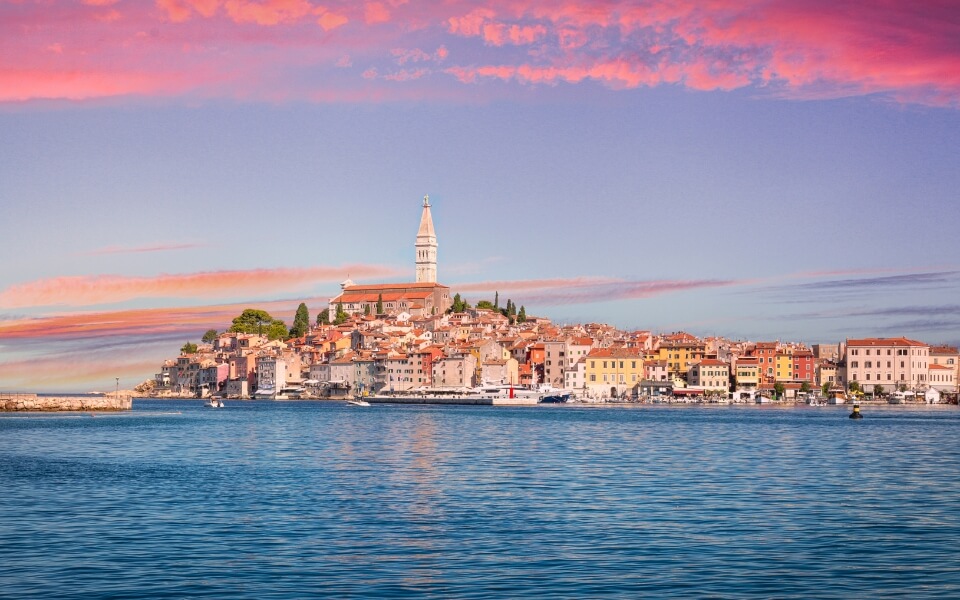 Istrian Peninsula
Istrian Peninsula
Day 1-2: Exploring the Istrian Peninsula (150-300m elevation)
Begin your electric adventure in Istria, often described as “Croatia’s Tuscany.” This comparison is well-earned—like its Italian counterpart, Istria boasts undulating landscapes of cypress-lined hills, ancient hilltop towns that appear frozen in time, and a culinary scene driven by exceptional olive oils, wines, and truffles. The peninsula’s terracotta-roofed villages perched atop verdant hills evoke the same timeless Mediterranean charm that has made Tuscany famous, yet with a distinctive Croatian character. This heart-shaped peninsula offers a perfect blend of natural beauty, gastronomic excellence, and cultural richness that makes it an ideal starting point for your electric vehicle journey.
Key easyCharging stations:
- Poreč: 150 kW DC fast chargers with CCS and CHAdeMO connectors near the shopping centre and restaurants
- Rovinj: 50 kW DC chargers with CCS, CHAdeMO and Type 2 connectors near tourist information and cafés
- Motovun: 22 kW AC destination chargers with Type 2 connectors at local vineyards
- Pula: 100 kW DC chargers with CCS and Type 2 connectors near shopping areas and historic sites
Regional driving considerations: Istria features moderate hills throughout the peninsula with a maximum elevation of 686m at Učka Mountain. Expect a 15-20% range reduction on mountainous routes, particularly when ascending to hilltop towns like Motovun and Grožnjan. In April, winds can be stronger than in May, so account for potential headwinds when planning your charging stops, especially if driving a shorter-range EV.
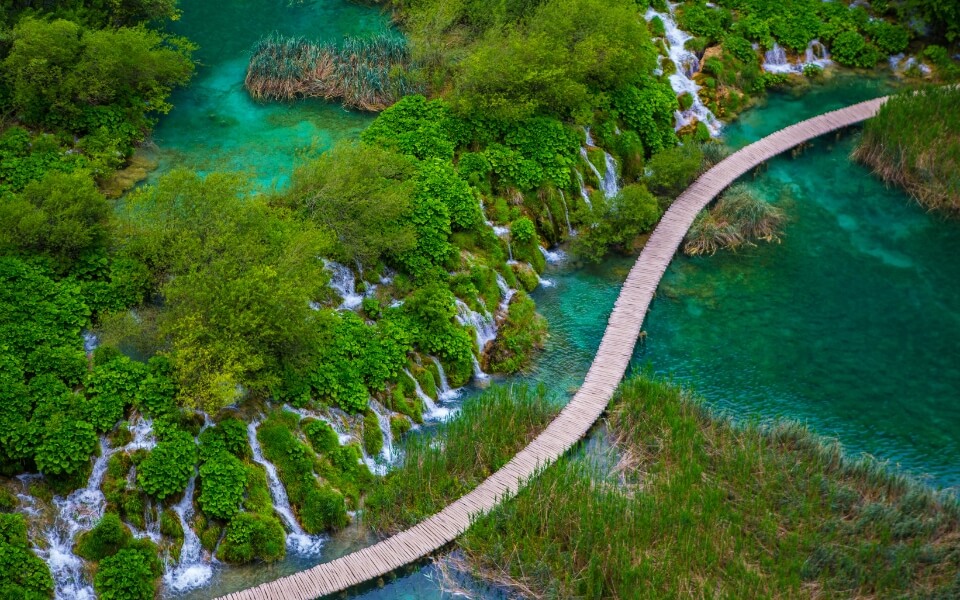 Plitvice Lakes National Park
Plitvice Lakes National Park
Day 3-4: Central Croatia and National Parks (200-600m elevation)
Head inland to discover Croatia’s stunning national parks and rural heartland, where significant elevation changes will test your EV’s efficiency. This region boasts several of Croatia’s most spectacular protected areas, all increasingly accessible to EV drivers:
-
Plitvice Lakes National Park: Croatia’s oldest and most visited national park features 16 terraced lakes connected by waterfalls. The visitor centre provides 100 kW fast charging, making it ideal for a full day of exploration.
-
Northern Velebit National Park: For the more adventurous EV drivers, this mountainous park offers pristine wilderness with remarkable biodiversity. While charging infrastructure is more limited, the nearby town of Otočac has easyCharging stations to use before and after your visit.
-
Risnjak National Park: Located closer to Zagreb, this forested mountain range offers excellent hiking with less tourist traffic than Plitvice. The nearby town of Delnice features easyCharging stations that make day trips convenient for EV drivers.
Key easyCharging stations:
- Plitvice Lakes: 100 kW DC chargers with CCS and CHAdeMO connectors at the visitor centre
- Slunj: 50 kW DC chargers with CCS and Type 2 connectors near a local bakery and café
- Karlovac: 150 kW DC chargers with CCS, CHAdeMO and Type 2 connectors at the shopping centre
Regional driving considerations: The Plitvice region features significant elevation changes with heights reaching 1,279m. You’ll encounter 25-35% range reduction in mountain passages, particularly on the winding roads approaching the national park. In April, temperatures at these elevations can be 5-7°C cooler than coastal areas, so factor in potential heater use. Use regenerative braking efficiently on descents to recapture energy, and consider charging to 90-100% before tackling the steepest routes.
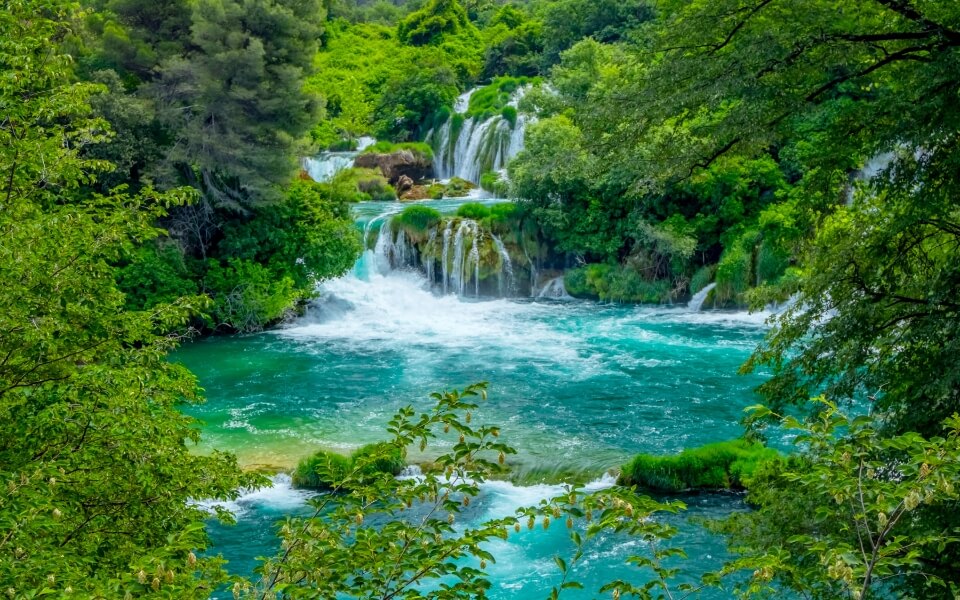 Krka Waterfalls
Krka Waterfalls
Day 5-7: Dalmatian Hinterland and Coastal Detours (300-800m inland, 0-400m coastal)
Explore the less-visited interior behind Croatia’s famous coastline, with rewarding coastal detours perfectly suited for electric vehicles. The beauty of this region lies in the ability to alternate between the rugged hinterland and the stunning Adriatic coast:
Optional Coastal Detours from the Hinterland Route:
-
Split Riviera: From Sinj, a 30-minute drive (35km) brings you to Split, Croatia’s second-largest city. The 150 kW easyCharging stations at the city’s shopping centres make it easy to explore Diocletian’s Palace—a UNESCO World Heritage site—while your vehicle charges. Continue along the coast to discover charming seaside towns like Omiš, where the Cetina River meets the Adriatic.
-
Šibenik and Krka Waterfalls: A worthwhile detour from Drniš (only 20km) leads to Šibenik, home to the UNESCO-listed Cathedral of St. James. The 50 kW chargers in the historic centre allow you to explore the medieval old town while charging. Nearby Krka National Park offers spectacular waterfalls less crowded than Plitvice, with a newly installed easyCharging station at the main entrance.
-
Zadar Peninsula: From Knin, head southwest (about 70km) to reach Zadar, a historic coastal city with Roman ruins, modern art installations, and the famous Sea Organ. The 100 kW easyCharging stations near the tourist area make it easy to enjoy the city’s famous sunset while your EV recharges.
Key easyCharging stations:
- Knin: 50 kW DC chargers with CCS and Type 2 connectors near the historic fortress
- Drniš: 22 kW AC chargers with Type 2 connectors near local producers and cafés
- Sinj: 75 kW DC chargers with CCS and CHAdeMO connectors in the town centre
- Split (coastal detour): 150 kW DC chargers with CCS, CHAdeMO and Type 2 connectors at the shopping mall
- Šibenik (coastal detour): 50 kW DC chargers with CCS and CHAdeMO connectors in the historic centre
Regional driving considerations: The Dalmatian hinterland features the most challenging terrain for EVs with steep mountain passes and elevations up to 1,831m at Dinara Mountain. Expect 30-40% range reduction on major ascents. If range anxiety is a concern, consider alternating between inland and coastal routes, as coastal driving typically results in only 5-15% range reduction.
Special April Consideration: If visiting during Easter celebrations, note that some rural charging stations may see higher usage as domestic tourism increases during this period. Using the easyCharging app to check real-time availability becomes even more important during holiday weekends.
Regional Specialty Tasting: A Culinary Journey for EV Travellers
What distinguishes this electric vehicle route is the opportunity to sample Croatia’s diverse regional cuisine while your car charges. Each area offers distinctive specialties reflecting local traditions and seasonal ingredients:
 Istrian prosciutto
Istrian prosciutto
Istrian Delicacies (While Charging in Poreč, Motovun or Rovinj)
- Truffles: The Istrian forests produce some of Europe’s finest black and white truffles. Many truffle-hunting experiences now offer EV charging while you explore.
- Extra virgin olive oil: Istria produces award-winning oils from indigenous olive varieties. Many producers have installed Type 2 charging points for visitors.
- Istrian prosciutto (pršut): Air-dried for at least 12 months and smoked using local woods. Several prosciutto producers near Motovun offer charging.
Charging tip: The 22 kW charger at Motovun’s vineyards provides the perfect opportunity for a leisurely tasting session while gaining approximately 100km of range per hour of charging.
 Medimurska gibanica
Medimurska gibanica
Central Croatian Specialties (While Charging in Plitvice and Slunj)
- Škripavac cheese: This squeaky, fresh cheese from the Lika region pairs beautifully with local honey. Several cheese producers near Plitvice have installed destination chargers.
- Medimurska gibanica: A layered cake with poppy seeds, cottage cheese, walnuts, and apples—perfect with a coffee during a charging stop.
- Fresh river fish: The pristine rivers of central Croatia offer excellent trout and carp dishes.
Charging tip: The 100 kW fast charger at Plitvice Lakes Visitor Centre will replenish most EVs to 80% in 30-40 minutes—just enough time to sample local cheeses at the adjacent restaurant.
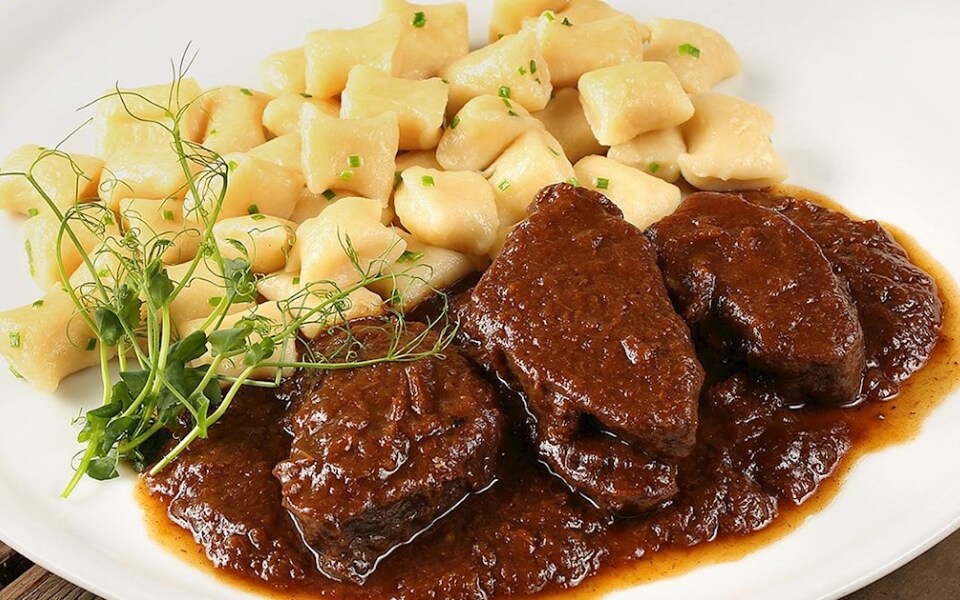 Pašticada
Pašticada
Dalmatian Specialties (While Charging in Knin, Drniš or Sinj)
- Pašticada: A rich beef stew marinated in wine vinegar and cooked with prunes, nutmeg, and other spices. Perfect for longer charging sessions.
- Soparnik: A Swiss chard-filled flatbread that’s a protected cultural food in Croatia.
- Drniški pršut: Protected designation of origin cured ham from the inland Dalmatian town of Drniš, with a distinctive smoky flavour.
Charging tip: The 22 kW AC charger in Drniš is located near several traditional konobas (taverns) serving authentic Dalmatian cuisine—ideal for a 2-hour lunch break while gaining approximately 40-50% charge.
EV Range Optimisation: Mastering Croatian Terrain
Croatian geography presents unique challenges and opportunities for electric vehicle drivers. Here’s our comprehensive guide to maximising range while navigating Croatia’s diverse landscape:
Mountain Driving Strategies
-
Anticipate elevation changes: Use the vehicle’s navigation system or apps like A Better Route Planner to identify significant climbs in advance. Consider how the Učka mountain (686m) in Istria, Plitvice highlands (1,279m) in central Croatia, and Dinara (1,831m) in Dalmatia will affect your range.
-
Start mountain routes with 30% more range than needed: The formula we recommend is: (normal route distance × 1.3) to account for up to 40% range reduction on steep mountain passes in the Dalmatian hinterland.
-
Utilise regenerative braking effectively: On the descent from Učka Mountain towards Opatija, you can recapture 10-15% of your battery capacity through skillful regenerative braking techniques.
Coastal vs. Inland Route Considerations
-
Coastal routes: The Adriatic Highway offers spectacular views with minimal elevation changes, resulting in only 5-15% range reduction compared to manufacturer estimates. However, strong crosswinds, particularly the famous “bura” (north wind), can increase consumption by 10-15%.
-
Inland routes: These typically involve more elevation changes but offer less wind resistance. The trade-off between wind and elevation must be considered when planning.
-
Island hopping: Croatia’s islands are increasingly EV-friendly with ferries accommodating electric vehicles. Brač, Hvar, and Korčula all have multiple easyCharging stations. Allow for 30-45 minutes of sailing time, plus loading and unloading.
Seasonal Efficiency Factors
As an early spring traveller, you should consider:
-
Variable temperatures: April temperatures can fluctuate more than in May, ranging from 8-20°C depending on location and weather conditions. Pack accordingly and expect to use some climate control, particularly in the mornings and evenings.
-
Occasional rain preparation: While not frequent, April showers are possible. Some EV models experience slightly reduced range (3-5%) in wet conditions due to increased rolling resistance. Plan with a small buffer in your range calculations.
-
Higher mountain passes: Some mountain passes above 1,500m may still have patches of snow in early April, particularly after a cold winter. Check road conditions before setting out for areas like Northern Velebit or the highest sections of the Dinara range.
-
Reduced tourism traffic: One significant advantage of April travel is dramatically reduced congestion compared to summer months, resulting in more predictable energy consumption and journey times.
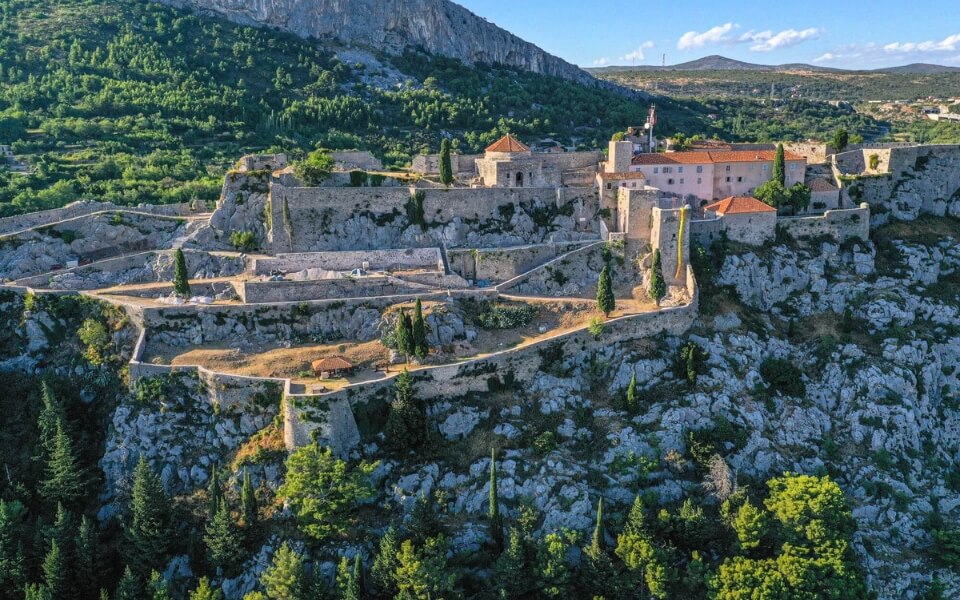 Klis Fortress
Klis Fortress
Hidden Gems Along Your Croatian EV Journey
The joy of electric vehicle travel in rural Croatia lies in discovering unexpected treasures—often in places where you’ve stopped to charge. Some highlights include:
-
Hum: Officially the world’s smallest town, this medieval settlement in Istria is perfect for exploring during a charging session. The nearby 22 kW charger lets you sample local biska (mistletoe brandy) while gaining approximately 50km of range per hour.
-
Rastoke: Often overlooked in favour of nearby Plitvice, this village built over waterfalls offers charming water mills and excellent local trout restaurants. The easyCharging 50 kW station here will recharge most EVs to 80% in under an hour.
-
Klis Fortress: Just 15 minutes from Split, this dramatic fortress (featured in Game of Thrones) offers spectacular views. The new easyCharging 50 kW station in the visitor car park makes it an ideal stop between coastal and inland routes.
Planning Your Croatian EV Adventure
Croatia’s commitment to sustainable tourism makes it increasingly EV-friendly, with new charging infrastructure appearing monthly. The easyCharging network (easycharging.app) continues to expand, particularly in rural areas where charging was previously limited.
Before setting off, download the easyCharging app, which offers:
- Real-time charger availability
- Filtering by connector type and charging speed
- Payment processing without additional RFID cards
This Easter holiday, embrace Croatia’s countryside with the quiet hum of your electric motor as your soundtrack. From the truffled treasures of Istria to the majestic mountains of the Dalmatian hinterland, Croatia offers the perfect blend of adventure, culture, and sustainable travel for EV enthusiasts.
Frequently asked questions
Not at all—April is a wonderful month for EV travel in Croatia. Temperatures typically range from 15-20°C on the coast and 12-18°C inland, providing good conditions for battery efficiency without requiring excessive climate control. While you might encounter occasional spring showers, these are typically brief and followed by sunshine. The landscape bursts with spring colours as wildflowers carpet the countryside, creating spectacular scenic drives without summer heat or crowds.
With the easyCharging network (available at easycharging.app), you’ll find that most stations are spaced between 50-80km apart along main routes. Rural areas are increasingly well-served, with a commitment to expand coverage by 35% through 2025. We recommend downloading the easyCharging app before travel, as it provides real-time availability information and the ability to filter by connector type.
Croatia’s mountainous interior can reduce range by 25-40% on the steepest sections, particularly in the Dalmatian hinterland. This varies by vehicle—heavier EVs with larger batteries tend to be more affected on ascents but can recapture more energy during descents. Lighter vehicles may perform better overall. To compensate, charge to 90-100% before tackling routes like the Zagreb-Split inland motorway or the roads leading to Plitvice Lakes.
Absolutely. Major islands like Krk, Brač, Hvar, and Korčula all have multiple charging points and are accessible by regular car ferries. Krk is connected by bridge and features six charging stations. For more remote islands, check charging availability before travel.
CCS and Type 2 connectors dominate the Croatian charging landscape. CHAdeMO is available at approximately 60% of fast-charging locations. Tesla drivers will find their proprietary network plus adapters will work seamlessly with the easyCharging network.

